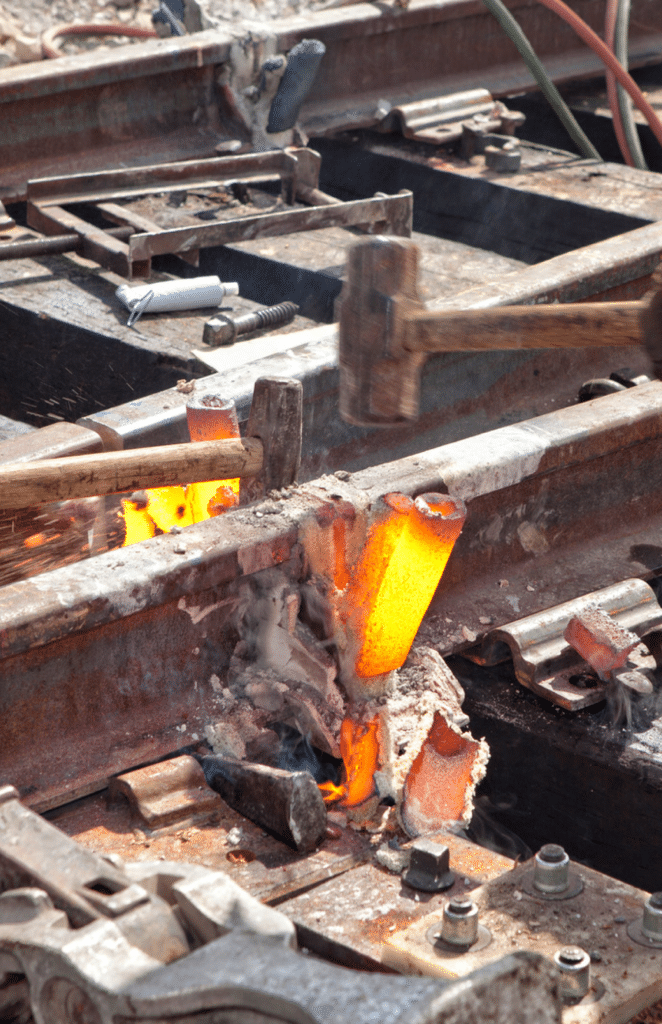11 Helpful Resources for Railroad Workers
Railroad workers face daily health and safety hazards, including toxic exposures, explosions, and outdated equipment. If you work for a railroad, you may be facing an unreasonable workload due to increasing personnel shortages from unresolved labor disputes concerning working conditions and compensation. Fortunately, eligible railroad workers may participate in a comprehensive retirement plan for themselves and their families.

Railway workers help form the backbone of the American economy. According to Fortune Magazine, railroads haul approximately 40 percent of the nation’s freight annually.
Americans have relied on railroads for nearly 200 years, according to the American Association for Railroads. Manufacturers in nearly every industry use railroads to provide inexpensive transportation of goods, saving consumers and taxpayers billions of dollars a day.
Today, railroad jobs have provided lifetime career opportunities affording workers such benefits as retirement, disability, and unemployment. Unfortunately, railroad jobs are rife with hazards that can cause serious occupational illnesses and injuries for railroad workers.
If you’re a railroad worker, here are some essential resources to consider.
Health and Safety Hazards
Railroad companies are large businesses that often cut costs to the point of endangering workers to protect profits. These cost-cutting measures can put workers in harm’s way due to:
- Exposures to toxic substances
- Derailments
- Poorly maintained equipment
- Worker shortages

Toxic Exposures
Railroad workers face daily exposure to toxic substances because companies may fail to provide appropriate personal protective equipment and conform to regulatory agency recommendations.
Asbestos
Asbestos was common until it became known as a carcinogen in the late 1970s. Railroad workers in many positions could have encountered asbestos in the following materials:
- Insulation in railcars, engine rooms, boilers, pipes, and electrical wiring
- Friction vehicle parts, especially brakes and brake linings
- Cement in railroad ties, stations, crossings, and yards
- Industrial adhesives throughout locomotives, railcars, and yards
- Electrical panels
- Wallboard
- Plaster
- Steam generators
- Fire bricks
Asbestos fibers may be taken home on the clothing and impact family members.
Illnesses Linked to Asbestos Exposure
Workers exposed to asbestos may develop the following illnesses later in life:
- Mesothelioma
- Lung cancer
- Colorectal cancer
- Esophageal cancer
- Asbestosis
Mesothelioma is cancer of the lining surrounding the lungs, stomach, or rarely, the heart or testicles. This devastating cancer progresses aggressively and often has a poor prognosis with a lifespan lower than two years, even with treatment.

Silica Dust
The Occupational Safety and Health Administration (OSHA) estimates that approximately 37 percent of railroad workers involved in ballast dumping or certain roadway maintenance machine duties inhale silica dust.
These dust particles are 100 times smaller than sand.
Illnesses Linked to Silica Dust Exposure
Silica dust may embed in the lungs and cause the following conditions:
- Silicosis
- Lung cancer
- Chronic obstructive pulmonary disease
- Kidney disease
Silicosis occurs when scar tissue forms in the lungs and impairs breathing. No cure has been found.
Diesel Exhaust
Diesel exhaust is classified as a known carcinogen by the International Agency for Research on Cancer. It may be inhaled through unburned diesel fuel and engine lubrication oil. OSHA regulates diesel exhaust, but the maximum permissible limit is controlled by feasibility rather than health, so the limit does not protect workers.
Illnesses Linked to Diesel Exhaust Exposure
According to the Water, Air, and Soil Pollution journal, ambient air concentrations of diesel exhaust are at a sufficient level to place workers in most railroad occupations at risk of the following occupational illnesses:
- Lung cancer
- Bladder cancer
- Lymphomas
- Testicular cancer
- Gastrointestinal cancers
- Multiple myeloma
- Prostate cancer
- Kidney cancer
Diesel exhaust contains ultrafine diesel particulate matter. The smaller the particle, the deeper it can be inhaled, increasing the risk of lung cancer. These tiny particles can make their way into the blood and lymphatic system, spread throughout the body, and cause cancer and gene mutations.
A study published in Industrial Health shows that railroad workers with the heaviest exposure included engineers, firemen, conductors, brakemen, and hostlers. Some shopworkers also experienced exposure.
Researchers observed the following health conditions in engine testing workers with one year of exposure or more:
- Airway inflammation
- Allergic respiratory disease
- Chronic obstructive pulmonary disease
- Lung cancer
- Reduced exhalation capacity
According to data from the Federal Railroad Administration, 192 workers became ill as a result of diesel exhaust inhalation from 2019 through 2022.
Benzopyrene
Diesel fuel also contains the toxic hydrocarbon benzopyrene, which has been associated with tumors of the following:
- Larynx
- Trachea
- Nasal cavity
- Esophagus
- Gastrointestinal site
- Respiratory sites
Benzene
Diesel exhaust may contain benzene. OSHA considers benzene toxic even at low levels. It has been linked to:
- Blood cancers
- Multiple myeloma
- Lung cancer
- Leukemia
- Lymphoma
Lead
Workers may be exposed to lead while:
- Removing lead coating during the demolition of railroad bridges
- Removing lead coating from railroad equipment
- Heating, machining, or spraying lead paint or other coatings onto railroad equipment

According to Quantum Compliance, a company specializing in environmental health and safety software, exposure to lead may lead to long-term damage of:
- The central nervous system
- The immune system
- Blood
- Reproductive organs
- The urinary system
Lead accumulates in the body, and its harmful effects are irreversible. Employees may take lead home on their work clothing, hair, or skin and expose children or other family members. This is especially dangerous for pregnant women and young children.

Solvents
Railroad workers handle a variety of solvents, including degreasing, cleaning, and paint solvents. Exposure may result in:
- Neuropathy
- Slowed motor skills
- Slower reflexes
- Decreased white matter
Decreased white matter can impair performance in cognitive tasks, according to the Journal of Occupational and Environmental Medicine.
Creosote
The Environmental Protection Agency has listed creosote as a probable carcinogen. Workers may be exposed to creosote when loading, unloading, installing, or repairing railroad ties. According to the Virginia Department of Health, long-term low-level creosote exposure may lead to:
- Sun sensitivity
- Respiratory tract irritation
- Skin blistering
- Worsened asthma
- Skin cancer
- Cancer of the scrotum

Magnetic Fields
The International Agency for Research on Cancer has classified extremely low-frequency electromagnetic fields as “possibly carcinogenic to humans.”
According to the Yeshiva University Observer, locomotive drivers working near these fields may sustain damage to their blood lymphocytes, a type of white blood cell. This increases the risk of terminal cancer and chronic lymphatic leukemia.
A Swiss study published in Occupational & Environmental Medicine also found a link between extremely low-frequency magnetic fields and the following cancers:
- Hodgkin’s disease
- Myeloid leukemia
Researchers observed that locomotive drivers experienced three to 20 times the magnetic field exposure level as yard engineers, attendants, and station managers.
Exposure to magnetic fields has also been linked to accelerated aging and a decrease in cells’ ability to adapt to environmental stressors.
Hazardous Materials in Transport
In addition to working with dangerous chemicals to maintain trains and tracks, workers must contend with hazardous substances hauled on trains every day, often in poorly maintained cars traveling on poorly maintained tracks. Trains transport the following toxic substances, according to the American Association of Railroads:
- Coal
- Inorganic chemicals
- Industrial gases
- Nonindustrial inorganic chemicals
- Industrial organic chemicals
- Fossil fuels
Industrial inorganic chemicals include:
- Sulfuric acid
- Anhydrous ammonia
- Hydrochloric acid
- Potassium chloride
- Soda ash
- Caustic soda
- Chlorine gas
Sulfuric acid, hydrochloric acid, and chlorine gas are listed in the Centers for Disease Control and Prevention’s top five chemicals resulting in injuries in a nine-state study in 2008.
Chlorine gas may cause irritation of the nose, eyes, and throat at low-level exposures. Coughing, changes in breathing rate, vomiting, and lung damage may occur with heavier exposure. Extremely high concentrations may be fatal. Lung collapse from inhaling chlorine gas and respiratory system corrosion may also occur.
Hydrochloric acid is a highly corrosive mineral acid that is also known as muriatic acid. It can cause irreversible harm to the respiratory organs, eyes, skin, and intestines.
Sulfuric acid is a highly corrosive, oily liquid. It can cause severe burns and permanent blindness if splashed into the eyes.
Industrial gases include vinyl chloride and liquefied carbon dioxide. In February of 2023, a derailment in East Palestine, Ohio, resulted in a massive explosion of toxic chemicals, including flammable vinyl chloride.
The Washington Times reported that workers, who were tasked with aiding in the site cleanup, experienced migraines and nausea. The workers allege that Norfolk Southern, the railway company that owns the derailed train, failed to provide protective gear, including respirators and eyewear.
Vinyl chloride exposure may lead to the following cancers, according to the National Cancer Institute:
- Lung cancer
- Brain cancer
- Liver cancer
- Lymphoma
- Leukemia
The Agency for Toxic Substances and Disease Registry reports that vinyl chloride can permanently damage the liver, create neurologic and behavioral symptoms, and change skin and hand bones. It can irritate the respiratory tract, eyes, and mucous membranes.
It targets the central nervous system and causes dizziness, inebriation, numbness, and visual disturbances. Exposure can even lead to coma and death.
Workers may be subjected to dangerous levels of vinyl chloride even if they do not smell it. By the time the gas is detectable by smell, it has reached a significantly dangerous level.
Industrial organic compounds regularly transported by rail include methanol, ethanol, and urea. Methanol is especially toxic, according to the Environmental Protection Agency, and may result in:
- Headache
- Dizziness
- Insomnia
- Nausea
- Gastrointestinal problems
- Blindness
Urea is noncombustible, but in a fire, it can give off toxic fumes. According to the International Labor Organization, urea inhalation can cause a cough and shortness of breath. Ingestion can lead to convulsions, headaches, nausea, and vomiting.
The railroads are major transporters of fossil fuels, such as crude oil, propane, and coal. Coal is the most important cargo railroads transport, accounting for approximately 45 percent of all cargo, according to Sightline Institute, an independent communication research center and think tank organization.
The biggest health risk with coal is that it can spread coal dust. Coal dust can blow out of the cars and land on the tracks, as it generally remains uncovered. This weakens the tracks over time, leading to derailments. It can also spontaneously ignite. Finding coal cars on fire at delivery is not uncommon.
Coal dust is hazardous to workers and may lead to pneumoconiosis, also known as black lung. According to the American Lung Association, when coal particles enter the lungs, the lungs attempt to remove them and become inflamed. The inflammation leads to the formation of scar tissue, which impairs breathing.
The primary danger with most other fossil fuels, such as crude oil and propane, is the potential for explosions, which can lead to inhaling toxic fumes and catastrophic burn injuries.
Derailments
Derailments can cause the release of noxious chemicals, such as in the East Palestine, Ohio, derailment. They can also create catastrophic fires and explosions that lead to workers sustaining serious physical injuries or death.
The Federal Railroad Administration’s 15 most dangerous railroad crossings in the United States are located in the following cities:
- Phoenix, Arizona
- Glendale, Arizona
- Ashdown, Arkansas
- Elmwood Park, New Jersey
- Muncie, Indiana
- Baton Rouge, Louisiana
- Evergreen, Alabama
- Pascagoula, Mississippi
- Cleveland, Ohio
- Waycross, Georgia
- Memphis, Tennessee
- Houston, Texas
The most common reasons for derailments are broken tracks and welds, track geometry, and railcar bearings failures.

Poorly Maintained Equipment
The railroad industry notoriously uses outdated equipment and fails to adequately maintain it. According to preliminary findings by the National Transportation Safety Bureau, the East Palestine, Ohio, derailment likely occurred due to overheated wheel bearings.
The Fort Worth Star-Telegram reported that tens of thousands of DOT-111A cars, the kind that carries crude oil and other hazardous materials, were built long before present-day safety standards were imposed and have not been upgraded.
They are a significant factor in many disasters, including such toxic leaks and derailments as:
- An ethanol leak from a punctured car near Newark International airport
- A nitric acid leak from a punctured tank car in Denver
- A derailment that led to a toxic pesticide leak in California
- A benzene spill near Superior, Wisconsin
- A tripropylene leak near downtown Baltimore stemming from a derailment
The Star-Telegram also reported that faulty tracks and improper operations contributed to these catastrophes.
When chemical spills occur, railroad employees may be called upon to assist in the cleanup, exposing them to the toxic substances even while residents within a mile of the sites are evacuated, as was the case following the East Palestine derailment.
Worker Shortages
Politico reported workers leaving railroads in large numbers, an unusual occurrence throughout railroad history and even a decade ago. However, in the last six years, the railroads have lost 45,000 workers. They compensate by overworking and abusing the workers they have left, which only increases the departures.
Worker shortages threaten to disrupt the supply chain and lead to increased safety concerns. With fewer workers, the railroads are less capable of providing sufficient maintenance to railcars, tracks, and locomotives. Safety protocols are more likely to be ignored.
The World Socialist Web Site reported that worker shortages could have partially contributed to the East Palestine, Ohio, derailment. Norfolk Southern had eliminated all five positions responsible for measuring the heat on railroad tracks and had delegated these tasks to untrained signal maintainers with already-full workloads.
How are the railroads addressing the worker shortages?
The railroads are actively recruiting employees, especially engineers and conductors. They offer hiring incentives and incentives to existing workers who recruit new workers.
Unions are negotiating improved working conditions, citing the worker shortage as an indication of poor work conditions such as inadequate pay and overly punitive attendance policies. However, negotiations have been ongoing since June 2021.
Injuries
In addition to occupational illnesses from toxic substances, railroad workers face the threat of serious bodily injuries due to these exposures and other hazards.
External Injuries
Railroad workers must often perform repetitive heavy lifting of 50 to 100 pounds throughout their shifts. They may experience catastrophic injuries when a train derails. They can also experience chemical burns when handling toxic materials.
According to the Federal Railroad Administration Office of Safety Analysis, 13,534 railroad workers were injured between 2019 and 2022, with 3,252 injuries and deaths in 2022 alone. Injuries were commonly caused by:
- Overexertion
- Slips, trips, and falls
- Being struck by objects
- Being crushed between objects
- Collisions
- Sudden, unexpected movements
- Stepping on objects
The most common injuries from these incidents include:
- Sprains
- Strains
- Bruises, cuts, and abrasions
- Broken bones
- Concussions
- Puncture wounds
- Burns
- Dislocations
- Electrical shocks
While less common, railroad workers have also experienced dislocations, amputations, dental injuries, and fatalities in the line of duty.

Injuries by Location
While railroad injuries occur throughout the country, they are markedly more prevalent in the areas indicated below.
States With the Highest Number of Injuries From 2019 to 2022
State
Number of Injuries
New York
2,461
New Jersey
1,085
Illinois
959
Pennsylvania
947
Railroads With the Highest Number of Injuries From 2019 to 2022
Railroad
Number of Worker Injuries
Amtrak
2,257
BNSF Railway Company
1,443
Long Island Rail Road
1,358
Union Pacific Railroad Company
1,215
Worker Positions With the Highest Numbers of Injuries
Train and engine transportation workers experienced 1,420 injuries in 2022. Overexertion, slips, trips, falls, or collisions were the most typical causes of injury.
Workers responsible for the maintenance of ways and structures sustained 830 injuries in 2022. They were injured most often from overexertion, struck-by accidents, slips, trips, and falls.
Workers that maintained equipment and stores sustained 616 injuries in 2022. They were most commonly injured due to overexertion, slips, trips, falls, and being caught, crushed, or pinched between objects.
Carpal tunnel syndrome, usually caused by repetitive tasks, is common in transit workers. But according to the Yeshiva University Times, this may occur in transit workers due to genetic damage stemming from exposure to hazardous chemicals.
Locomotive drivers often develop severe back injuries over time due to poor seating. The railroads provide low-quality seats that do not absorb train vibrations well, which transfers the vibrations to the driver. As many as 40 percent of employees report back pain from riding on trains, and 25 percent report neck pain.

Hearing Loss
The Federal Railroad Administration reported that 165 railroad workers were injured from 2019 to 2022 after being exposed to noise over time. This is especially prevalent in locomotive drivers, who are exposed to loud noises almost constantly.
Loud noises can damage the inner ear or the nerve between the brain and the inner ear, resulting in sensorineural hearing loss. This condition is irreversible.
Post-Traumatic Stress Disorder
Locomotive drivers, engineers, and other crew members who witness horrific accidents at railroad crossings can be left with post-traumatic stress disorder from having near-death experiences and witnessing others’ deaths.
Post-traumatic stress disorder involves a cluster of symptoms such as nightmares, flashbacks, and anxiety. It can cause severe reactions when the worker is reminded of a trauma, such as when conditions mimic what preceded that accident.
The disabling psychological injury of post-traumatic stress disorder can prevent workers from resuming their duties.

Regulations to Protect Workers
State and federal laws provide the means for workers to hold railroads accountable and receive compensation after an occupational injury or illness, especially if the injury is severe enough to prevent the worker from returning to work.
The Federal Employees Liability Act (FELA)
The most important law protecting railroad workers is the Federal Employees Liability Act, more commonly known as FELA. FELA was originally passed in 1908, then amended multiple times, with the most recent amendment in 1994.
FELA gives railroad employees the right to sue the railroad company for injuries. This contrasts with most other occupations, which require employees to file workers’ compensation claims. FELA is advantageous because workers’ compensation provides limited benefits and FELA provides a fuller remedy including pain and suffering.
FELA allows railroad workers to pursue economic and noneconomic damages. Economic damages are compensation for medical expenses and lost wages projected over a lifetime.
Noneconomic damages are compensation for quality-of-life losses that cannot be measured in dollars. These include pain, suffering, inconvenience, mental anguish, loss of bodily functions, and disfigurement.
Another important difference between workers’ compensation and FELA is that workers’ compensation is a no-fault system that does not require workers to prove employer negligence to receive benefits. A FELA claim does require workers to prove that negligence by the railroad caused or contributed to the injury.
However, the burden of proof in FELA claims is lower than in personal injury claims, which require proof that the other party’s negligence is the proximate cause of injury. FELA claims only require the slightest proof of negligence, and the railroad can be held liable even if negligence played a slight role in the injury.
You are eligible to file a FELA claim as an employee of any railroad involved in interstate commerce which nearly all major railroads are. If you have suffered an injury due to a railroad manager or employee’s negligence while carrying out operations or maintaining equipment, including train cars or tracks.
If the negligence caused the death of the employee, the personal representative may file a wrongful death lawsuit under FELA on behalf of the spouse, children, or next of kin.
Being partly responsible for an accident that led to an injury or illness does not automatically prevent you from recovering compensation, but your compensation will be adjusted in proportion to your share of the fault.
You could be barred from recovering compensation if it is determined that you were the sole cause of your injury.
A claims agent works for the railroad and functions in a similar capacity as an insurance adjuster. Railroads do not use insurance companies because they can afford to self-insure.
The primary difference between a claims agent and an insurance adjuster is that the claims agent works for your employer and can access your records. A claims agent can also report everything you say to the railroad’s FELA lawyers.
Claims adjusters may purport to be helping you with your FELA claim, but their purpose is to minimize compensation, and they are good at what they do. If you have been injured on the job, you must hire your own railroad accident lawyer to ensure an experienced advocate is on your side.
FELA requires employees to file their FELA lawsuits within three years of the injury. It can take substantial time to prepare a case before filing, so finding an experienced FELA attorney promptly after your injury is key to receiving a thorough case investigation and proper preparation ahead of the deadline.
FELA prohibits railroads from implementing or enforcing contracts or stipulations that exempt the railroad from FELA liability. Saying that you assumed the risk of injury when you accepted your position is also not a suitable defense.
The Locomotive Inspection Act
The Locomotive Inspection Act makes the railroad 100 percent liable for injuries that stem from any mechanical problem with railroad equipment. It is not necessary to prove negligence in Locomotive Inspection Act cases.
A Locomotive Inspection Act case is different from a FELA case but should be handled by an experienced FELA lawyer, who can determine which type of case is best for your situation.
Railroad Worker Benefits
Railroad benefits are a federal program administered by the Railroad Retirement Board. These benefits include monthly retirement, survivor, disability, and unemployment payments. Benefits payments are known as annuities.
Retirement Benefits
Railroad retirement benefits offer an alternative to Social Security retirement benefits with significantly higher payments in many cases.
Any worker employed by the following may qualify for railroad retirement benefits:
- Interstate railroads and their affiliates
- Employer associations in the railroad industry
- National railway labor organizations and their subordinates
Workers with at least 30 years of service are eligible for full retirement benefits at the age of 60. Workers with 10 to 29 years of service or at least five years of service after 1995 are eligible for full retirement benefits at their full retirement age, which varies based on the year of birth.
When calculating the time of service, each month of work performed is counted as one credit. Service months need not be consecutive. Military service can be counted if you meet the following criteria:
- You worked in railroad service in the same or preceding calendar year.
- You entered military service involuntarily or during wartime or a national emergency.
The monthly annuity varies based on your time of service. It is adjusted annually for inflation. According to the Railroad Retirement Board, an employee with 34.9 years of service aged 60 or older could expect to receive $4,553 per month as of 2022, or $6,368 if there is also a spouse.
The amount will be lower for employees with fewer than 30 years of service. For example, an employee with 20.3 years of service at full retirement age could expect to receive $2,927 per month as of 2022 or $4,058 with a spouse and 22.1 years of service.
The Two-Tier System
The monthly annuity amount is calculated using complex formulas in a two-tier system. Tier I is based on a combination of Social Security credits and railroad credits and is calculated using Social Security formulas.
Tier II is based on railroad credits only and is comparable to retirement benefits in other industries. Tier II amounts are generally higher than Social Security and Tier I amounts.
Each employee’s annuity has Tier I and Tier II components calculated into the formula.
Supplemental Annuities
Employees 60 or older with 30 years of service or 65 years or older with 25 to 29 years of service and a current connection to the railroad industry can also receive supplemental annuities. This includes $23 plus $4 for each year of service over 25 years, with a maximum of $43 for employees with 30 or more years.
Workers who have worked for the railroad for 12 months during the past 30 months are generally considered to have a qualifying connection.
Spouse Annuities
A spouse qualifies for a monthly annuity when the employee retires and both reach the age of 60 with 30 years of employment or 62 with fewer than 30 years.
Divorced spouses are also eligible for Tier I annuity plans provided the marriage lasted at least 10 years, the spouse is unmarried, and both have reached the age of 62.
Survivors Benefits
Widows and widowers are eligible for annuities at age 60, or ages 50 to 59 if totally disabled and unable to work. Survivor annuities may be paid to a divorced spouse at the Tier I level. Survivor annuities can also be paid to:
- Unmarried minor children
- Unmarried disabled children under age 22
- Unmarried dependent grandchildren if both parents are deceased or disabled
- Dependent parents aged 60 or older
Lump sum payments are also provided to assist with funeral expenses. In 2022, the average lump sum was $922. Lump sums may be paid to the surviving spouse, funeral home, or payer of funeral expenses.
You have the right to appeal within 60 days by requesting reconsideration. If you are denied again, you can appeal to the Bureau of Hearings and Appeals. Appeals then progress to the Railroad Retirement Board’s three-member panel, with the final appeal addressed to the U.S. Court of Appeals.
It is possible to draw benefits from both programs, but your railroad benefits will be reduced by the amount of Social Security benefits you receive. This also applies to any other benefits you receive, such as public, nonprofit, or federal pensions.

Disability
You may qualify for disability annuity payments if a disability keeps you from your regular railroad occupation at age 60 and you have at least 10 years of service. You may qualify at any age if you have at least 20 years of service and a current connection. A five-month waiting period is required.
If you are totally disabled and cannot perform regular work, you may qualify for disability with 10 years of service. Totally disabled workers with less than 10 years of service and at least five years after 1995 may qualify for Tier I benefits.
If you have reached the age of 65, you qualify for free hospital insurance under the Medicare program. If you are under 65, you may be eligible for Medicare if you have qualified for disability benefits for at least the past 24 months and if you have an insured status under Social Security rules.
Unemployment
Unemployment for railroad workers is managed by the Railroad Retirement Board. To qualify, you must have railroad earnings during the preceding calendar year, also known as the base year. For unemployment purposes, the calendar year is reset each year on July 1.
First-year employees need at least five months of creditable earnings during the base year. At any time, your earnings during your base year must be at least two-and-a-half times your base monthly compensation.
You can receive up to 26 weeks of unemployment benefits during each calendar year. Workers with 10 or more years of service may be able to extend these benefits.
While collecting unemployment, you must not receive vacation pay or other forms of compensation. You must be ready, willing, and able to work. Unemployment benefits are taxable.
In the event of unemployment because of participation in a strike, the strike must not violate the Railway Labor Act, and it must be authorized by the national office of the striking labor organization.
Unions
Railroad unions provide advocacy and collective bargaining services on behalf of workers. Unions sometimes organize strikes as part of the bargaining process.
Railroad workers have several unions from which to choose. Some unions are open to all railroad workers, while others are based on the type of work performed or geographical location.
Unions are governed by the Railway Labor Act, which ensures disputes are handled promptly without disrupting the movement of goods for commerce. Workers who belong to a union may be able to obtain assistance from the union when handling employment disputes or applying for benefits.
Union membership is not free. Union dues can generally be paid on a monthly or annual basis. Union membership is not mandatory.
Whistleblower Protection
A railroad whistleblower is an individual who reports employer wrongdoing and safety concerns to the appropriate authorities, such as OSHA. The Federal Railroad Safety Act protects employees from retaliation by the railroad when the employee does any of the following:
- Provides information to a federal agency or assists in an investigation
- Refuses to violate federal safety or security laws or work in hazardous conditions
- Files a safety complaint or testifies in a legal proceeding
- Reports a hazardous condition
- Reports a work-related injury or illness
- Accurately reports hours on duty
- Requests first aid or medical assistance
- Follows a physician’s orders
Unfortunately, the railroads have historically violated the Federal Railroad Safety Act. MPR News in Minneapolis reported that fear of retaliation discouraged railroad employees from talking to federal investigators about the transport of undocumented hazardous substances.
Their fears are not unfounded. According to the workers, employees who expressed safety concerns were targeted. Railroads have made OSHA’s list of the 10 worst offenders with more than 2,000 retaliation complaints filed against them.
In a 2021 case, MPR News in Minneapolis ordered BNSF Rail Company to reinstate an employee and pay the employee $290,000 in back pay, damages, and fees after determining the worker was unfairly terminated for reporting a safety issue.
